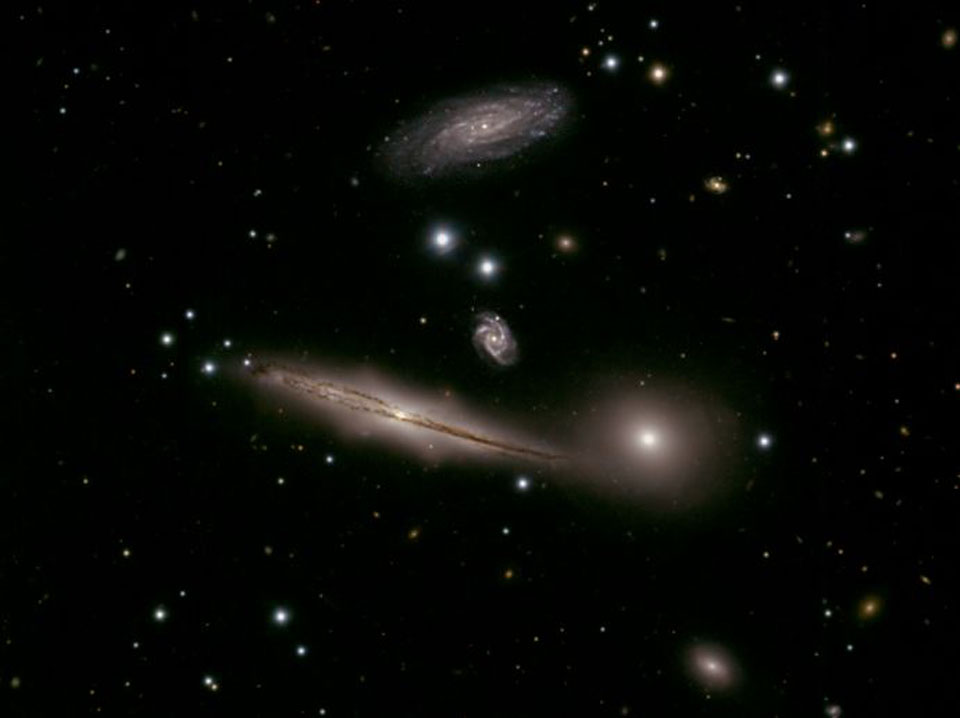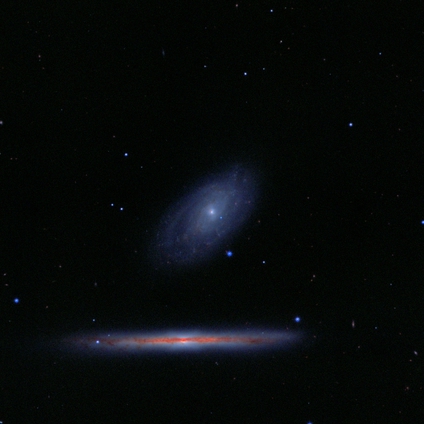Question for the science team about galaxies with x-shaped nuclei.
-
Some galaxies look like they have x-shaped nuclei in the UKIDSS images, like the one over here. But when you take a look at the Skyserver image the x-shape has (almost) gone. Is there any (scientific) significance to that?
Posted
-
Here is another one that is very visible in the UKIDSS image, but not so much in the Skyserver image

Posted
-
 by
vrooje
admin, scientist
by
vrooje
admin, scientist
Because UKIDSS is at longer wavelengths, it can see through the dust in an edge-on galaxy more easily, and the X-shape comes from a galactic bar, which is mostly in the inner part of the disk as opposed to the outer parts.
Posted
-
Thanks vrooje 😃. So the x-shapes are real after all 😃
Posted
-
 by
vrooje
admin, scientist
by
vrooje
admin, scientist
Oh, definitely! They are structurally very interesting.
Posted
-
 by
williamaskew
by
williamaskew
I believe they are formed by the vertical, up and down movements of the stars as they travel up and down and out of the galactic plane.
Posted
-
 by
c_cld
by
c_cld
NGC 4710
Still an astrophysical mystery, the evolution of the bulges in spiral galaxies led astronomers to the edge-on galaxy NGC 4710. When staring directly at the centre of the galaxy, one can detect a faint, ethereal "X"-shaped structure. Such a feature, which astronomers call a "boxy" or "peanut-shaped" bulge, is due to the vertical motions of the stars in the galaxy's bar and is only evident when the galaxy is seen edge-on. This curiously shaped puff is often observed in spiral galaxies with small bulges and open arms, but is less common in spirals with arms tightly wrapped around a more prominent bulge, such as NGC 4710.

Credit: NASA & ESA
😃Posted
-
Thanks all 😃.
Capella05 and I collect them for a Galaxy Zoo collection (and some volunteers too, like wtaskew). Maybe it would be a good thing to start a Discussion and list them.
(Uh oh, there are already 226 in my collection. If I start a discussion I'd better post a few every now and then. Maybe posting the link to my collection will suffice: http://talk.galaxyzoo.org/#/collections/CGZS000h8w ).
Posted
-
 by
Alpha_Aurigae
in response to wtaskew's comment.
by
Alpha_Aurigae
in response to wtaskew's comment.
This leads me to another question about bowtie-shaped galaxies. Do stars in those galaxies also travel up and down the galactic plane? Or are other factors responsible for the galaxies' shapes?
http://talk.galaxyzoo.org/#/boards/BGZ0000001/discussions/DGZ10068xt
(Drat, every time I want to take a break from GZ something interesting pulls me back in again 😃 )
Posted
-
 by
williamaskew
in response to Alpha Aurigae's comment.
by
williamaskew
in response to Alpha Aurigae's comment.
i think you are looking at bowties face on as opposed to the edgeon with X-shaped
Posted
-
Yes, that thought just occurred to me too. So other factors cause the bowtie shape.
Posted
-
 by
HMB6EQUJ5
by
HMB6EQUJ5
excellent images......it's a small small universe after all. Thanks Alpha Aurigae!
Posted
-
 by
Budgieye
moderator
by
Budgieye
moderator
Thank you for all the information. Added to Index.
2.2 Nucleus, Nuclear bulge, and bulgeless X-shaped nuclei http://talk.galaxyzoo.org/#/boards/BGZ0000001/discussions/DGZ0000wrb?page=2&comment_id=53d8b8190d43f776b000107c
Posted
-
 by
Budgieye
moderator
by
Budgieye
moderator
Great image of X-shaped bulge on APOD 2015 August 9 http://apod.nasa.gov/apod/ap150809.html
"HCG 87: A Small Group of Galaxies
Image Credit: GMOS-S Commissioning Team, Gemini Observatory
Explanation: Sometimes galaxies form groups. For example, our own Milky Way Galaxy is part of the Local Group of Galaxies. Small, compact groups, like Hickson Compact Group 87 (HCG 87) shown above, are interesting partly because they slowly self-destruct. Indeed, the galaxies of HCG 87 are gravitationally stretching each other during their 100-million year orbits around a common center. The pulling creates colliding gas that causes bright bursts of star formation and feeds matter into their active galaxy centers. HCG 87 is composed of a large edge-on spiral galaxy visible near the image center, an elliptical galaxy visible to its right, and a spiral galaxy visible near the top. The small spiral near the center might be far in the distance. Several stars from our Galaxy are also visible in the foreground. Studying groups like HCG 87 allows insight into how all galaxies form and evolve."http://apod.nasa.gov/apod/ap150809.html


NGC 6946 NGC6946 Arp 29 PGC 65415 PGC65415
Image Credit: GMOS-S Commissioning Team, Gemini Observatory
Posted
